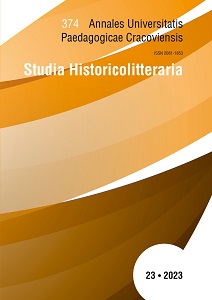Jana Ziółkowskiego rozrachunki z polską historią (Kawaler złotej ostrogi)
Jan Ziółkowski’s reconciliation with the Polish history (Kawaler złotej ostrogi)
Author(s): Maria Jolanta OlszewskaSubject(s): Studies of Literature, Political history, Modern Age, 16th Century
Published by: Wydawnictwo Uniwersytetu Komisji Edukacji Narodowej w Krakowie
Keywords: historical novel; the Republic of Poland; Cecora; Sarmatism; postcolonialism; Jan Ziółkowski;
Summary/Abstract: Jan Ziółkowski’s historical novel entitled Kawaler złotej ostrogi (1967), which was preceded by the trilogy Homo novi (1955), is about the events of the first half of the 16th century. By means of historical narration, the author conducts a debate with Sienkiewicz’s vision of the Polish history, created “to comfort the hearts”. This allows the writer to reconcile with the idealized image of the Polish Lithuanian Commonwealth, preserved in social mentality, deconstruct its image and create an alternative to Sienkiewicz’s narration. Difficult, painful, humiliating and embarrassing issues, such as social and national differences, submission (race differentiation, dominance, subordination, inequality, oppressiveness), as well as national vices, come to the fore in the novel. The plot is about the life of three characters: Marek Jakimowski – a Catholic nobleman, Stefan Satanowski – an Arian nobleman, and Jan Stołczyn – a liberated peasant. Each of the characters experiences oppression because of an unjust system based on the principles of “golden freedom.” Ziółkowski used a traditional model of a historical novel, creatively transformed the sources that were accessible to him, and built his own historical reconciliation narrative. This is an example of engaged writing.
Journal: Annales Universitatis Paedagogicae Cracoviensis. Studia Historicolitteraria
- Issue Year: 2023
- Issue No: 23
- Page Range: 239-255
- Page Count: 17
- Language: Polish

